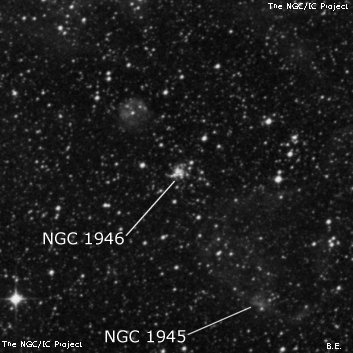
S-L 470 lies 7' E. Observed with a 25" on 4/3/19 it appeared bright, fairly small, round, compact, 35" diameter, contains a very small bright nucleus.
John Herschel discovered NGC 1946 = h2854 on 3 Jan 1837 and recorded "pF, R, gbM, resolvable." Herschel credits Dunlop with the discovery (D 237), though in the GC and NGC a question mark was added. Dunlop's position matches this cluster very well though the description "a rather large faint nebula, 3' or 4' diameter, of an irregular round figure, no central attraction" implies a much larger object -- probably NGC 1948, whose center is just 6' NNE of his position.
600/800mm - 24" (11/18/12 - Magellan Observatory, Australia): bright LMC cluster, fairly small, irregularly round, high surface bright glow, 30" diameter. Although this knot was not resolved, it is situated in a glorious rich star field surrounded by numerous stars. A stream of stars, oriented SW to NE, seems to pass through NGC 1946, extending southwest to NGC 1945 (4.4' SSW) and northeast to NGC 1948, a magnificent star cloud and HII complex ~8' NNE. A brighter, parallel stream, consisting of stars of mixed magnitudes and unresolved glow (stars or nebulosity) is roughly 3' W, extending at least 10' SW to NE.
Notes by Steve Gottlieb